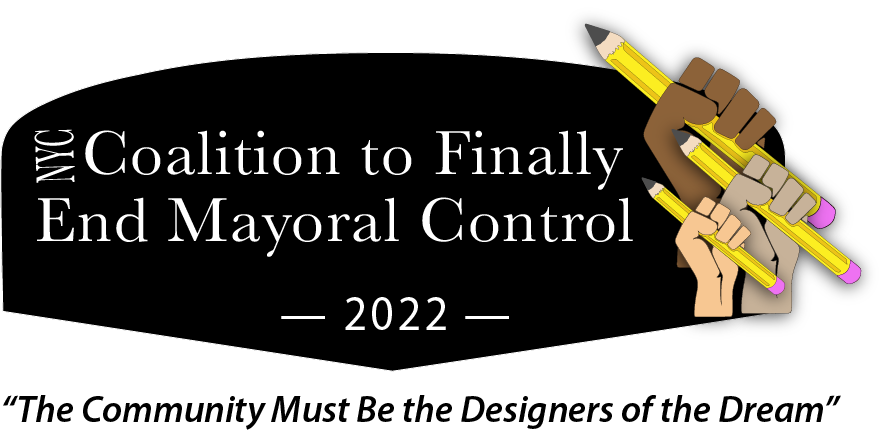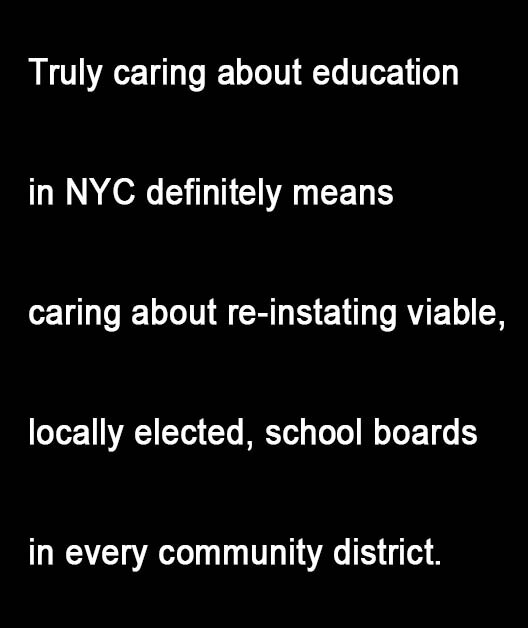Beto— a Texan— asks the BEST Question:
Beto O’Rourke on Why Politics is Personal in a Democracy: What happens when we can’t vote?
An interview with Rachel Maddow, April 7, 2021
“What happens when you can’t vote in school board elections to your kids’ school?
How are they going to be represented?”
Voting for, and sitting on a true school board outside of NYC is where democracy is rooted. It is where democracy is learned and practiced every day… by every day people who have the utmost concern for their community and its children. And that’s exactly why Mr. O’Rouke mentioned school boards as primary in his discussion on the right to vote being personal.
Without consensus and citizen consent, Michael Bloomberg persuaded state law makers to give him solo control over the schools in 2002, and thus, basically eliminate real elected school boards. No one in NYC ever got to vote on whether we wanted mayoral control and the removal of our community school boards. But to pacify legal outrage, the state mandated that some kind of board elections had to occur. We were instructed that Community Education Councils (CECs), in addition to four Citywide Education Councils (in other words, powerless advisory panels) would adequately replace elected school boards and meet the needs of NYC’s diverse school communities just fine.
Fact is, they absolutely do not.
Under mayoral control, our Education Councils have neither the power nor the legal authority to govern the same as elected school boards do throughout most of NY State and across America.
There are over 14,000 school districts governed by 95,000 school board members in the United States. Click here to read this interesting report.
FACTS: There are 705 democratically elected schools boards in the state of New York. Why isn’t NYC one of them?
Learn about the power of “Real” School Boards in this Nation vs. NYC’s Powerless Education Councils
“In addition to teaching democratic values directly, we must also address the hidden curriculum—what is taught to students implicitly, through how we conduct ourselves as a society, perhaps most important being how we choose to run our schools. As Century Foundation policy associate Kimberly Quick has noted, our schools “not only reflect our current values as a nation, but also reveal the values that we anticipate passing along to the next generation of Americans.”
According to the NY State School Boards Association (NYSSBA), New York Education Law defines a school board’s general powers and duties. Generally a school board oversees the district’s affairs (students’ education), personnel and properties. The board has specific responsibilities to approve curriculum, employ a superintendent and submit a proposed budget to the district voters for their approval.
For nearly 100 years, local school boards have been an essential and fundamental part of public education. A school board is a local version of quintessential American representative government. Its members are vested with the authority to act on behalf of those they serve and to make big decisions for their district.
School boards exercise local control over education—and more than that, they articulate and pursue a community's hopes for its young people.
School boards set the vision, goals, and policy for the district.
The school board has a dual role: To represent the concerns of the citizens, taxpayers and parents to the school administrators, AND to represent the needs of the students and school district to the citizens, taxpayers and parents of the community.
School boards select and hire superintendents for their districts. This decision is considered their most important decision since superintendents serve as the chief executive officers of school boards. The school board does not operate the district on a day-to-day basis; that is the job of the superintendent, who is the district's chief executive. Rather, the school board sets the policies, goals and objectives for the district – and it holds the superintendent responsible for implementing the policies and achieving the goals.
The superintendent answers to the board, implementing policies and directives, making recommendations, providing leadership, and generally serving as a resource. As the chief executive of the district, the superintendent handles day-to-day operations, oversees staff, and stays current on state and national education issues.
The school board monitors all outlays of money for the school district. This includes discussing and finalizing budgets for the district each year, monitoring spending activity to ensure it meets budgetary guidelines, and making tough decisions when cuts are necessary. The board also reviews proposals submitted for new construction, school renovations and other major investments of district funds.
Parents—and the public at large— attend school board meetings, ask questions, volunteer, get involved in their local schools, vote, and hold the board accountable.
“Are the voices of parents and community members heard as a part of decision-making, or are they shut out by state takeovers and billionaire philanthropists who bankroll reform efforts? Are teachers, parents, and students involved in determining how schools are run, or do principals get the only voice? Do students have access to economically and racially integrated schools where they are treated equally, or are they segregated into separate and unequal schools or tracks within schools? These are all critical questions.”
- Putting Democracy Back in Public Education, The Century Foundation
— A Power Analysis —
The only real power the CECs have pertains to Zoning.* Other than that one issue, the mayor and chancellor (as overseer) make all the decisions. As we’ve all witnessed over almost 2 decades, the choice is theirs whether or not to even listen to recommendations by the well-intended people who sit on the CECs, much less implement their ideas or act upon their concerns.
Furthermore, the Panel for Educational Policy (PEP) is a top-down rubber stamp for the will of the mayor. There is zero accountability to NYC’s parents and students… to the community’s concerns… to the taxpaying public… and most especially, to voters.
Lastly, under mayoral control, the NYC DOE has the sole authority to say who can and can’t vote for Community Education Council representatives (only 1 parent of a student residing in the local school district). Although elsewhere across the state and throughout most of America, “School districts may not require voters to pay taxes or have children attending the public schools to be eligible to vote (Kramer v. Union Free Sch. Dist. No. 15, 395 U.S. 621 (1969).”
As per the NYC DOE’s website:
“New York City's Community and Citywide Education Councils are charged with promoting student achievement, advising and commenting on educational policies, and providing input to the chancellor and the Panel for Educational Policy.”
“The powers and duties of Community Education Councils are specified in NY State Education Law §2590-e:”
Review the district’s educational programs and assess their effect on student achievement.
Hold at least one meeting per month with the superintendent (72-hour notice required), open to the public, where the public may discuss the current state of the schools in the district.
Submit an annual evaluation of the superintendent to the Chancellor.
Provide input to the Chancellor and the Panel for Educational Policy on district concerns.
Serve as liaisons to School Leadership Teams
*Approve zoning lines as submitted by the superintendent.
Hold public hearings on the district’s capital needs and submit a plan to the Chancellor.
Hold a Town Hall with the Chancellor.
Education Council members must also fill out monthly Individual Performance Reports and file yearly financial disclosures.


